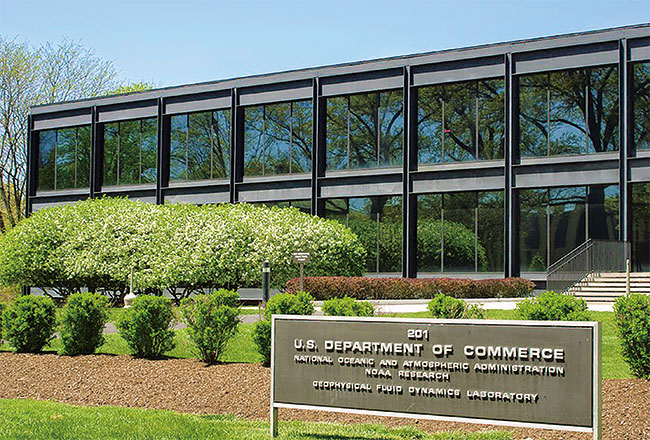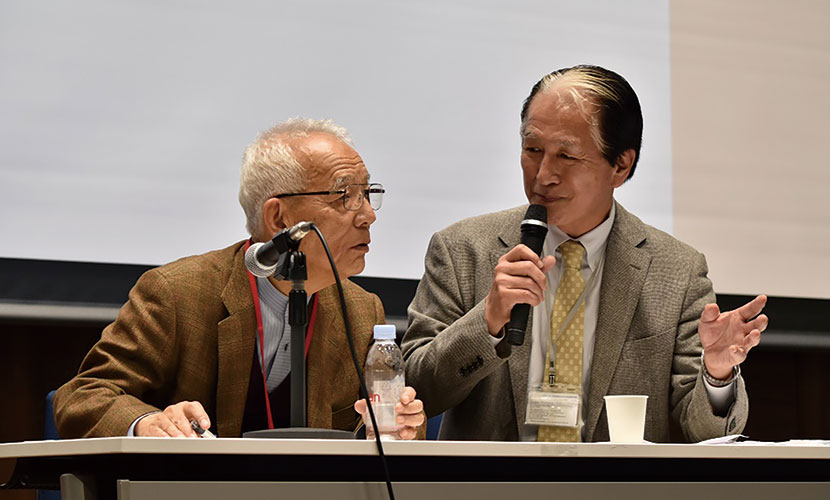Disclaimer: machine translated by DeepL which may contain errors.
A Fresh Breeze in Princeton
Toshio Yamagata, Emeritus Professor, The University of Tokyo
 Geophysical Fluid Dynamics Laboratory (Geophysical Fluid Dynamics Laboratory: Princeton University Forrestal Campus) |
As a junior member of the Department of Earth and Planetary Physics (now the Department of Physics) in the Faculty of Science, I am very proud that Dr. Yoshiro Manabe has won the Nobel Prize in Physics. Dr. Manabe received his degree in meteorology from Professor Shigekata Masano in 1957, and immediately moved to the U.S. Weather Bureau's (now the U.S. Atmosphere and Ocean Research Institute) Geophysical Fluid Dynamics Laboratory, where he has led the world in global warming prediction research for more than half a century. Since the degradation of the global environment has reached the point where it threatens the sustainability of human society on a planetary scale, his achievement in making it possible to simulate future climate based on the laws of science is an outstanding achievement. I think it is groundbreaking that the Nobel Prize selection committee has shed light on such complex science. John von Neumann, the founder of artificial intelligence, foresaw the seriousness of climate change and said, "The problems of weather and climate will unite the interests of all nations more than nuclear threats or other wars," and I think the time has come.
The origin of the Geophysical Fluid Dynamics Institute, to which Dr. Manabe belongs, is in line with the history of general-purpose computers. It is related to von Neumann's choice of weather forecasting as the first application of general-purpose computers. The Institute for Advanced Study in Princeton, established by Abraham Flexner "as a place for the free exploration of useless knowledge," was the site of the first computer-based weather forecasting experiments. Confident in this success, von Neumann began designing the Institute for "ultimate forecasting," that is, climate prediction. Perhaps it was in preparation for a nuclear winter. Thus, in 1955, the Institute for Geophysical Fluid Dynamics was established at the then U.S. Weather Bureau in Washington, D.C., and Joseph Smagorinsky was appointed its first Director. Director Smagorinsky entrusted Dr. Manabe with the development of the atmospheric general circulation model and Kirk Bryan with the development of the ocean general circulation model. In 1967, Director Smagorinsky moved the Institute to Princeton, the site of von Neumann's inspiration for climate research, to strengthen ties with Princeton University and promote interdisciplinary climate research in an academic atmosphere. This was a wise decision. I think this was a wise decision. Rapid advances in computing power have made it possible to reproduce the entire global climate and even its seasonality, and to study the effects of artificially doubling the concentration of carbon dioxide on the climate of different regions of the world. Thus was laid the foundation for the models now used by the Intergovernmental Panel on Climate Change (IPCC).
In the 1980s, when I was at the Geophysical Fluid Dynamics Institute, there was a growing interest in understanding natural variations in climate, such as El Niño. Director Smagorinsky understood and supported the study of these natural variations as a direct contribution to social activities close to home.
 |
| At the special lecture "Global Warming and the Ocean" held on October 31, 2017. Dr. Manabe on the left and the author on the right (hosted by the Ocean Policy Institute of the Sasakawa Peace Foundation and supported by the Graduate School of Science, The University of Tokyo and the Japan Agency for Marine-Earth Science and Technology). |
I believe that knowledge that seems useless is born in the heaven of scientists who immerse themselves in research based on curiosity and free thinking. On the other hand, scientists must also have an interest in applications. This is because an awareness of applications to society will promote the development of sound science. Director Smagorinsky seemed to have a good understanding of the richness of the relationship between basic science and society. I believe that the fact that the group of researchers who gathered at Princeton from all over the world, with Dr. Manabe at the head of the group, have been able to develop their research with a sense of curiosity and contribute to the design of a future society for mankind in cooperation with each other from various perspectives is largely due to the free and refreshing wind that Dr. Smagorinsky brought to the city of Princeton. I believe that the free and fresh wind that Director Smagorinsky brought to Princeton had a great effect.
Published in the November 2021 issue of Faculty of Science News


